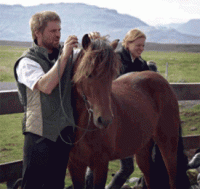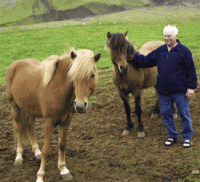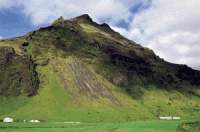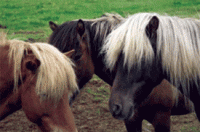Iceland- Hoofbeats in the Land of Fire and Ice




By Judie Framan
Photography by Elliot Framan
We heard the sound first; the TAKA TAKA TAKA TAKA of hoofbeats along the road. Then we saw them, 90 horses in every color imaginable; blacks, bays, duns, browns, cremelos, palominos, even a pinto. Necks arched high, long tails floating, manes waving, Icelandic horses executing the punctuated four-beat rhythm of the "tolt," the breed's distinctive running walk.
The riders stopped at the Golden Waterfall, Gullfoss, to rest the horses. They told me that they had been on the road for six days, riding from Skagafjordas in the north over the Rjolur mountain track to the Geyser Hot Spring area.
"We travel as much as eight hours a day to cover the distance," said our trekking guide, Hauhur Hanksson. "We take hand horses along, and change our mounts a couple of times a day, which allows us to travel at a comfortable speed. The rest of the herd runs along with us," he explained.
Icelanders have traveled this way for centuries because there simply was no other way to get around the sparsely populated rugged territory of the island. Today, horse trekking and pleasure riding is the third most popular sport in Iceland, and one of the fastest growing businesses.
My husband and I traveled to Iceland to learn about the natural wonders of this land of fire and ice. Rugged moss covered lava fields greeted us as we touched down at Keflavik International Airport near Reykjavik, the capital of Iceland, where about 180,000 of the 300,000 inhabitants of the island live.
Iceland is an island nation in the northern Atlantic Ocean that sits between Greenland and Great Britain. It is on the mid-Atlantic ridge separating the North American and European tectonic plates. It is therefore a land of active volcanoes. The island was settled between the late 9th century and the mid 11th century by Norwegians and Celts who came in increasing numbers, populating the island's hard-scrabble land. In the year 930 AD, they established the world's oldest parliament at Thingvellier, which is also the place where the continental plates drift apart.
Today, another kind of explorer comes to Iceland. Increasing numbers of people travel to the Icelandic highlands to escape the stressful nature of modern life. They discover the calming peace and tranquility of the vast unspoiled natural beauty of Iceland from the back of a horse born to climb mountains, gallop across fields and forge rivers.
You don't have to drive very far in Iceland to find the Icelandic horse. They are everywhere, grazing peacefully in pastures and on the hillsides. My husband and I were on our way to one of the most characteristic sights in Iceland, the Snaefellsness peninsula, named after the glacier covered cone volcano, Snaefellsjokull. In fact, Snaefellsnes has been called "Iceland in a nutshell" because of the diversity of the landscape. We were struck by the breathtaking scenery; light-colored sandy beaches surrounded by vast lava fields, lush pastures, the clear blue of the Atlantic Ocean, and cloudless azure skies overhead.
We visited the farm and museum of Hildibrandur Bjarnason at Bjarnarhofn where I encountered my first Icelandic horse breeder. He was enormously proud of his horses, and through an interpreter told me of his prized mare who had won top honors at the national show, Landsmot. Then he took me into a pasture and introduced me to a dozen young geldings of every color imaginable. He told me that there were 40 different colors and about 100 variations in the breed. One of the breeding goals for the Icelandic horse is the preservation of all varieties of coat color within the breed. The wide range of colors is a distinguishing factor of the breed. A blue dun with a flaxen mane and tail and a white star was friendly and followed me everywhere. Hildibrandur called him Evening Star.
We caught up with Sigurbjorn Bardarson, one of Iceland's most famous trainers known world-wide as Diddi, at a regional horse show in Hella, an unassuming town of 500 people on the Ring Road. It marks the beginning of the countryside where the most famous of the Sagas, Njals Saga took place, and the area where the famous Eyjatiallajekull glacier rises majestically from the valley floor. Fredrick Palsson, managing director of the Hotel Ranga invited us to see part of the Pace competition that was being held at the horse park in Hella.
"Horse showing in Iceland is a family affair," Fredrick explained. "Often parents and children compete in various classes," he said. He told us that Diddi had been riding since he was 11 years old, and that his daughter started competing at age five.
Diddi explained that there is a distinction between Icelandic show horses and the trekking horses. "Show horses are specifically trained to tolt or pace, and have no other job."
The procedure in the pace competition starts with the horses cantering around an oval. When ready, horse and rider approach the straight away of the track, break down to the pace, and pass through an electronic beam that begins the timing. They pace as fast as then can for 330 feet (100 meters) and are timed again. The horse with the fastest time wins. If they break into a canter, they are disqualified. Diddi won the Pace competition that evening.
Back in Reykjavik we spent the afternoon with Einer Bollason, the managing director of Ishester, the largest riding facility and trekking company in Iceland. The Riding
center is located a short 15 minutes from the capital center, and is worlds apart from the hustle and bustle of the city. Einer explained the characteristics of the breed. He told us that a serious breeding program, the Horse Breeders Union, had started about 40 years ago. Breeding goals were set, and are strictly adhered to today. The official goal is to produce a healthy, fertile and durable horse; robust Icelandic horse. Conformation standards are important, but this is a horse that is bred to be a riding horse.
Today the Icelandic horse is an essential companion for the tens of thousands of Icelanders young and old, as well as a growing number of visitors to the island. Icelanders enjoy their horses in various ways: horse shows, competitions, contests, races, ceremonies and leisure riding in both winter and summer, and there are hundreds of riding clubs throughout Iceland. No other breed of horse can claim such a status in the minds of a whole nation.
The purity of the breed and the history surrounding the Icelanders and their horses, which have played such an integral role in daily life, makes this a trip for equestrians like no other.




